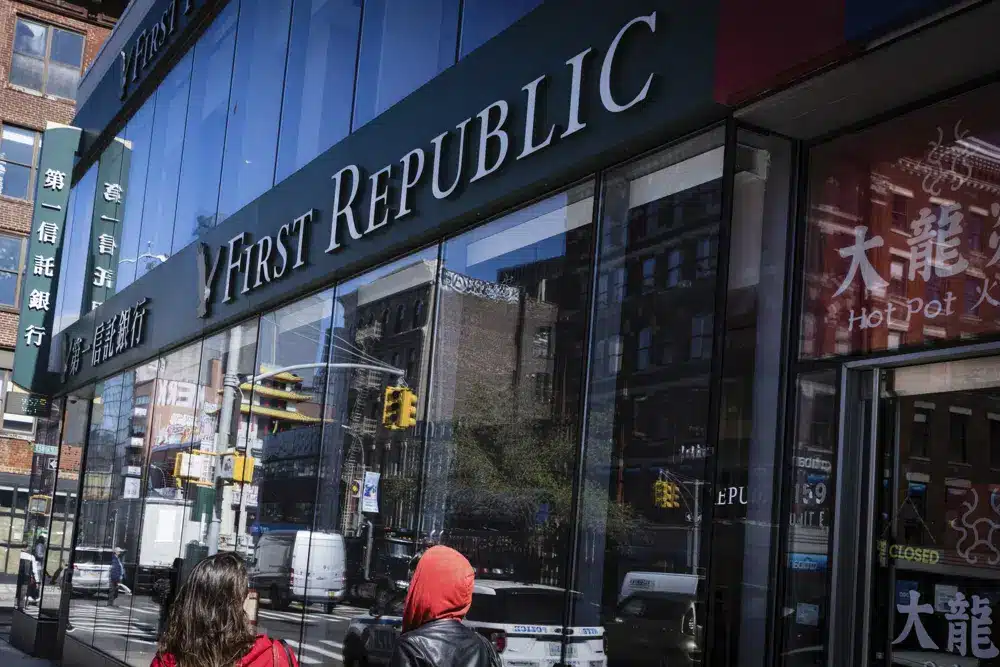Cryptocurrency
2023: First Republic Bank Seized, Sold In Fire Sale To JPMorgan

NEW YORK (Reuters) – Regulators seized insolvent First Republic Bank early Monday, making it the second-largest bank failure in US history, and immediately sold all of its deposits and most of its assets to JPMorgan Chase to resolve the upheaval that has raised concerns about the soundness of the US banking system.
It is the third midsize bank to go under in less than two months. The only larger bank failure in US history was Washington Mutual, which went bankrupt at the height of the 2008 financial crisis and was taken over by JPMorgan in a similar government-managed deal.
“Our government invited us and others to step up, and we did,” JPMorgan Chase Chairman and CEO Jamie Dimon said.
JPMorgan Chase took over First Republic’s 84 locations on Monday, acquiring the bank’s $92 billion in deposits and $203 billion in loans and other instruments. The bank’s stockholders are expected to be wiped out as part of the sale.
In a conference call with reporters and investors, Dimon stated that “this part of this (banking) crisis is over.” Other midsize banks reported their results last week, and the vast majority of them showed that deposits had stabilized and profits remained healthy. The First Republic was an outlier.
Before this year, First Republic was the banking industry’s envy. Its opulent branches provided warm cookies to its clients, who were nearly entirely wealthy and powerful. Its bankers enticed wealthy clients with low-cost mortgages and appealing savings rates to sell them on higher-profit ventures such as wealth management and brokerage accounts. In exchange, the wealthy rarely defaulted on their loans and deposited large sums of money in banks that could be borrowed elsewhere.
However, with Silicon Valley Bank’s and Signature Bank’s failures, that business model of catering to the wealthy became a liability. These banks had many uninsured deposits or deposits that exceeded the FDIC’s $250,000 limit. Clients with big accounts at First Republic, like those at Silicon Valley Bank and Signature Bank, quickly withdrew their funds at the first sign of problems.
In a note to investors, Timothy Coffey, an analyst with Janney Montgomery Scott, stated, “Too many (First Republic) customers demonstrated their true loyalties were to their fears.”
Last month, a group of a dozen banks put together a $30 billion funding package for the First Republic, which appeared to stop the bleeding of deposits for a time. However, it became clear that the First Republic needed more time: it needed to find a buyer or find new sources of funding to replace the deposits that had left the bank.
The First Republic intended to liquidate underperforming assets, such as low-interest mortgages supplied to rich clients. It also disclosed plans to lay off up to a quarter of its workers, estimated to be over 7,200 in late 2022. Analysts, though, saw it as too little, too late. For weeks, the bank appeared to be on the verge of failing.
According to Jeremy Barnum, JPMorgan’s chief financial officer, the $30 billion deal “bought time when time was needed” for the First Republic.
Last Monday, First Republic reported its first-quarter results, shocking analysts and investors by revealing that $100 billion in deposits had flowed out of the bank, most of which occurred in mid-March, immediately following the failures of Silicon Valley Bank and Signature Bank. During an earnings conference call, its executives took no questions from analysts. The stock of First Republic dropped by more than 50% the next day.
By the middle of last week, it was evident that the government needed to intervene in the First Republic. Treasury officials requested that banks submit bids for the First Republic, and bankers and regulators worked all weekend to find a solution.
JPMorgan is so large that it would be illegal to buy the First Republic.
JPMorgan Chase, the nation’s largest bank and a dealmaker in times of crisis, was once again the government’s go-to bank. Last month, Treasury officials appointed JPMorgan to head the $30 billion rescue package. Dimon was Washington’s go-to banker 2008 to find private solutions to the banking crisis, and JPMorgan acquired both Bear Stearns and Washington Mutual.
The Federal Reserve and FDIC, which, together with the Office of the Comptroller of the Currency, govern the banking industry, may face greater scrutiny for their management of First Republic. Both admitted in separate studies on Friday that inadequate supervision contributed to Silicon Valley Bank’s and Signature Bank’s failures.
“When interest rates were low, these banks were allowed to grow too big too fast,” Coffey explained in an interview.
There may now be concerns about JPMorgan Chase’s size, which has more than $3 trillion in assets and is by far the largest of the “too big to fail” firms worldwide.
Regulators “allowed the country’s largest bank to grow even larger.” “We expect this to be a Democratic focus for months,” said TD Cowen banking analyst Jaret Seiberg.
JPMorgan is so large that it would be illegal to buy the First Republic since no bank in the United States can have more than a 10% market share of deposits. JPMorgan was only able to step in because the First Republic failed.
JPMorgan described the First Republic transaction as favorable to the financial system and the company statement. As part of the arrangement, the FDIC will share losses on First Republic’s loans with JPMorgan. The FDIC estimates that First Republic’s failure will cost the insurance fund approximately $13 billion, which bank assessments rather than taxpayers pay.
JPMorgan anticipates First Republic to increase its net income by $500 million yearly, but it expects to incur $2 billion in costs integrating First Republic into its operations over the next 18 months.
SOURCE – (AP)































